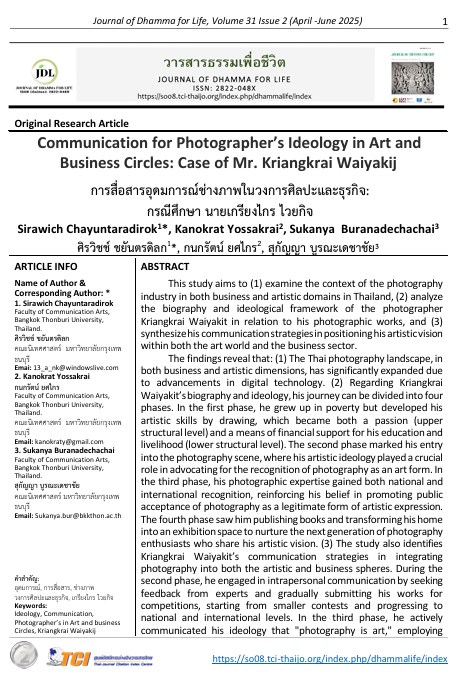Communication for Photographer’s Ideology in Art and Business Circles: Case of Mr. Kriangkrai Waiyakij
Main Article Content
Abstract
This study aims to (1) examine the context of the photography industry in both business and artistic domains in Thailand, (2) analyze the biography and ideological framework of the photographer Kriangkrai Waiyakit in relation to his photographic works, and (3) synthesize his communication strategies in positioning his artistic vision within both the art world and the business sector.
The findings reveal that: (1) The Thai photography landscape, in both business and artistic dimensions, has significantly expanded due to advancements in digital technology. (2) Regarding Kriangkrai Waiyakit’s biography and ideology, his journey can be divided into four phases. In the first phase, he grew up in poverty but developed his artistic skills by drawing, which became both a passion (upper structural level) and a means of financial support for his education and livelihood (lower structural level). The second phase marked his entry into the photography scene, where his artistic ideology played a crucial role in advocating for the recognition of photography as an art form. In the third phase, his photographic expertise gained both national and international recognition, reinforcing his belief in promoting public acceptance of photography as a legitimate form of artistic expression. The fourth phase saw him publishing books and transforming his home into an exhibition space to nurture the next generation of photography enthusiasts who share his artistic vision. (3) The study also identifies Kriangkrai Waiyakit’s communication strategies in integrating photography into both the artistic and business spheres. During the second phase, he engaged in intrapersonal communication by seeking feedback from experts and gradually submitting his works for competitions, starting from smaller contests and progressing to national and international levels. In the third phase, he actively communicated his ideology that "photography is art," employing strategic audience analysis, defining objectives, selecting appropriate media and messages, fostering audience engagement, and utilizing visual storytelling through images, sound, and motion. He also adopted a multidimensional presentation approach with a positive framing, leveraging books, exhibitions, and online platforms. Finally, in the fourth phase, his communication strategy focused on preserving and transmitting his artistic vision by publishing the book Drawing with Images and transforming his home into a photography gallery, which served as an open communication channel for his dedicated audience and followers.


